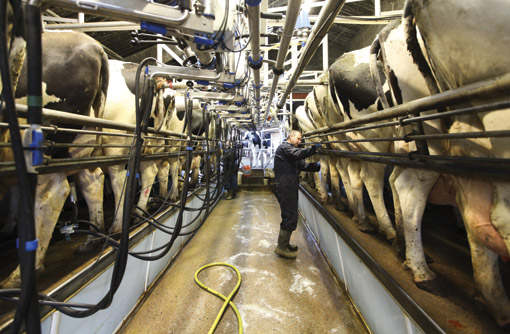Why carbon footprinting your farm is important

These days, more and more products we buy have a carbon footprint figure printed on the packet.
A bag of crisps has a carbon footprint of around 80g and there’s about 53g of carbon in every cup of tea. As more and more food products have these tags, there will be a knock-on effect for the farmers producing the raw materials.
The idea behind carbon footprinting is simple enough – you take all the raw materials, processes, transport and other inputs into a product, business, process or activity, and add together all the carbon emissions from each of these stages. That’s the carbon footprint.
But then it gets complicated. You will know that there can be numerous different stages that go into most everyday products. A pint of milk, for example, needs to take into account raising the cows needed, including all their feed, housing and vet care. Not to mention the methane cows give off all by themselves. Then added in are any transport costs. After that, there is the carbon produced when milking. All this, before the milk even leaves the farm.
There are also different scopes of carbon footprinting. You can calculate just the electricity, gas, or other fuels used by the farm.
You could include all the extras, such as the vet’s carbon footprint, and the carbon footprint of any cow feed. Or you can take it a step further and incorporate everything that goes into the milking process – all the transport, for example.
So what’s the benefit of carbon footprinting for farming businesses? There are two main reasons why farms should be considering it.
Firstly, it’s a way to start making real efficiencies, and therefore cost savings, within your business. Knowing exactly where and how you are using your resources – and so generating a carbon footprint – is one of the best ways to do this.
A recent study suggests that electricity prices could rise by as much as 88% by 2020.
For farms rearing intensive livestock, or other activities that have a high energy use, this represents a major increase in overheads.
But there are ways to decrease energy use – and carbon footprinting will show you where you could be saving.
“Carbon footprinting can be a useful pointer for farms. If it will show where they’re using too much energy, then it can help to cut costs.”
Margy Hall, farm owner
Once you know how and where you are using energy, you will know where you can invest to make the best cost savings.
And then there’s the pressure from retailers. Most major retailers are now bringing in efficiency and carbon-reduction targets, driven by pressure from legislation and customers.
These retailers are expecting continuing efficiency measures right through their supply chains. There may even come a time when companies demand that all their suppliers know their carbon footprint, and actively reduce it.
This means that the farmers that act now, and get their carbon footprint calculated, can make sure they are in the best position to meet this growing need from their customers. It’s a chance to differentiate, retain customers, and get new business.
However it’s not something that many farmers are doing.
Paying for consultancy is one drawback – especially when there’s no obvious immediate return for the cost. Carbon footprinting definitely helps farmers analyse where to make the best investments, and gain new customers.
The question must therefore be, can you afford not to?
Woolrow Farm, West Yorkshire
Savings prove value of measuring emissions
Woolrow farm, a 500-cow dairy farm in West Yorkshire, has taken part in carbon footprinting with a major retailer.
The exercise looked at the footprint of the farm’s grain production and herd, along with milking and processing facilities.
As well as taking part in carbon footprinting, the farm has brought in several energy efficiency measures, that have cut its yearly energy use by 30,000kWh. The farm invested in a heat-exchange system in its refrigeration process, as well as a trailing shoe to make more efficient use of fertiliser and slurry.
The heat-exchange unit alone is saving the farm £2,000 a year.
This new equipment, combined with other energy-efficiency measures, such as slow-start vacuum pumps in the milking facility, have cut the farm’s electricity use by 15%.
“Carbon footprinting can be a useful pointer for farms. If it will show where they’re using too much energy, then it can help to cut costs,” says farm owner Margy Hall. “But there will always be a clash between expansion and cutting carbon emissions.
“Our results were interesting, but to make them relevant to a farm they need to be specific and take into account different farming methods.”
Keep up with the latest news on renewables
